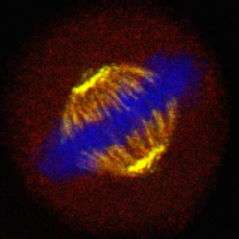The team of proteins that could have implications for the fight against cancer

(Phys.org) —Researchers at Warwick Medical School have identified the key role played by a team of proteins in the process of mitosis. Working out how to control them may give scientists a way to destroy cancerous cells.
The study, published in The Journal of Cell Biology, highlights the role of a newly identified team of proteins, TACC3-ch-TOG-clathrin, in forming inter-microtubule bridges that stabilise the kinetochore fibres (K-fibres) used in mitosis.
When a cell divides, it produces a mitotic spindle which then makes sure that the chromosomes are divided equally between the two new cells. Failure to do so efficiently can lead to problems; those cells with either too few or too many chromosomes are at risk of becoming cancerous.
In order to do this the mitotic spindle uses K-fibres to allow for chromosome movement around the cell. These fibres are comprised of even smaller microtubules, bundled together via what may be termed 'bridges' – which is where the team of proteins comes in.
Clathrin is a protein that is involved in the process of membrane trafficking in interphase cells, but it switches role during mitosis and localises to the mitotic spindle where it works alongside TACC3 and ch-TOG to form these bridges.
When TACC3 is removed from the cell, the clathrin is no longer able to bind the microtubules. Other bridges do exist but they only represent about 40% of the total so the microtubules, and as a result the mitotic spindle, are significantly weaker.
By developing methods to rapidly remove the team of proteins, the researchers have been able to determine that removing TACC3 allows us to make the cells arrest and die.
Steven Royle, Associate Professor in Biomedical Cell Biology, explained, "That sounds like a negative, the idea of a cell dying. However it's vital to remember that most adult cells are no longer dividing and what we are suggesting is being able to shut down mitosis in those that are multiplying."
There are other functions associated with cell division that would need to be considered, such as repairing damage, but Royle firmly believes that this is still an important step in tackling cancerous cells.
He added, "Though it isn't yet capable of being fully targeted to kill only cancerous cells, neither are the current treatments. Existing drugs like taxanes, for example, do not discriminate between cancerous cells and normal cells. Hopefully the next development will allow us to use a greater understanding of how this team of proteins can be used in a more clinical environment."
More information: www.jcb.org/cgi/doi/10.1083/jcb.201211127
Journal information: Journal of Cell Biology
Provided by University of Warwick


















